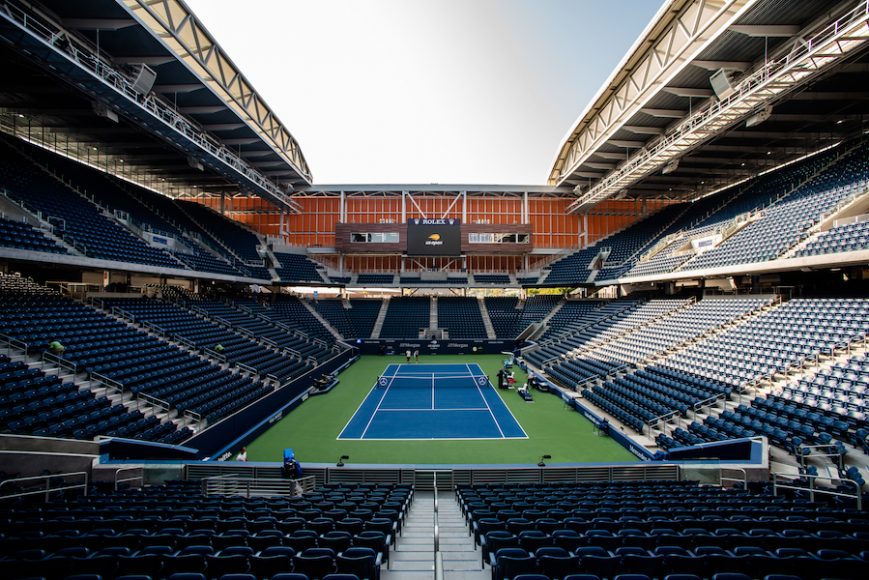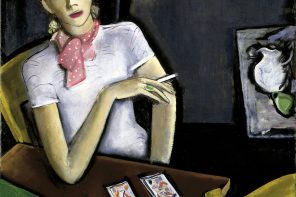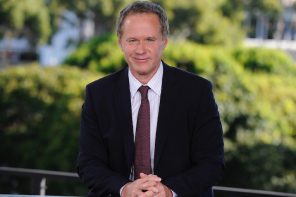“So, what’s new at the US Open?”
When we ask this question annually of Daniel Zausner — chief operating officer of the USTA Billie Jean King National Tennis Center in Flushing Meadows-Corona Park, Queens — it usually leads to a discussion about some new piece of infrastructure at the complex to delight players and fans alike. And there will be a new building this season. (More on that in a bit.)
But this year, “What’s new?” is as loaded as a question can get, as Zausner himself acknowledged during a recent interview. Not only will the White Plains-based USTA’s presentation of the Open — one of the first live major sporting events to take place in the metro area for some time — be unprecedented, but it will come on the heels of the organization and the site’s key role in stemming the tide of the coronavirus in New York City, once the epicenter of the virus in the world.
The Open will be played on its regularly scheduled dates, Aug. 31 through Sept. 13 but without spectators in a streamlined format. There will be no qualifying, juniors, mixed doubles or wheelchair competitions and the draws for the men’s and women’s doubles have been halved from 64 to 32 teams each. (The men’s and women’s singles draws will remain unchanged, with 128 players each.)
This year, the tournament will be preceded at the Queens site by the Western & Southern Open (Aug. 19 through 28), another tournament in the USTA’s US Open Series, which is usually held at the Lindner Family Tennis Center in Mason, Ohio.
“We’re looking to mitigate risks and control as much as possible,” said Zausner, who added that the decisions were made after considering a dozen different scenarios and working closely with the Association of Tennis Professionals (ATP), the men’s group and the Women’s Tennis Association (WTA).
To that end, the players will be housed in two hotels, one of which is the revamped TWA Hotel at John F. Kennedy International Airport, whose centerpiece is Eero Saarinen’s iconic, winged 1962 landmark, the TWA Flight Center. The players will each be given two hotel rooms, one paid for by the USTA, and allowed to bring up to three guests, Stacey Allaster, the USTA’s chief executive, professional tennis, and the recently appointed director of the US Open tournament, said at a press conference. A Realtor will also be available for those who wish to rent a house nearby, population-dense Manhattan excluded. Players and their teams will be tested for the coronavirus upon arrival and periodically. There is a protocol in place for treating any who may test positive, Allaster added.
With the absence of spectators on-site, the players will have access to a resort-like atmosphere that will include the outdoor cafés, Arthur Ashe Stadium lounges and a South Plaza that will be transformed into a sports center with everything from soccer to golf, basketball, movies and gaming. On court, there will be fewer officials, with no lines persons except at Arthur Ashe and Louis Armstrong stadiums, Zausner said. (The outer courts will make use of Hawk-Eye Live technology for line calls, an Open first. All courts will have chair umpires.) Ball persons will be age 18 and over, he added, and will wear masks and gloves. They will not hand towels to players, who will each use their own set of tennis balls.
The general media will not be allowed to attend the Open, although the USTA is building a two-story, 20,000-square-foot broadcast center in time to accommodate its more than 200 international broadcast partners. (ESPN has its own on-site facility to carry the matches and conduct interviews.) The new facility, along with everything else will be subject to state-of-the-art sanitation, created in partnership with ISSA, which bills itself as the leading trade organization for the cleaning industry worldwide.
“We wanted to set the standard,” Zausner said.
If all of this seems surreal, think back to where the USTA was in the spring. In March, 12 courts in its Indoor Training Center became a temporary hospital with 475 beds. Patients began arriving in April with the last leaving mid-May. Though the makeshift hospital would include 22 ICU beds and embrace 100,000 square feet of space, it was, fortunately, never fully occupied.
In addition, “the Louie,” as the Louis Armstrong Stadium is known, became a commissary that prepared 25,000 meal packages a day — containing two days’ worth of breakfast, lunch and dinner — for patients, health care workers and underserved children who would otherwise receive breakfast and lunch from the New York City public schools. At its height, the Louie served up to 150,000 meals a day, helping to bolster neighboring Elmhurst Hospital, which Zausner described as “the epicenter of the epicenter.”
It’s an extraordinary achievement, one that he modestly downplayed.
“It felt good, but we have to remember the people who were the real heroes,” he said. “We’re just glad we could do our small part.”
Now things are back to normal or rather the new normal. It will be strange not to hear the buzz and the roar of the crowd, which Zausner called “the pulse” of the Open. But he and the USTA team are committed to an experience that will engage the fans virtually.
“We see what the PGA and Nascar have done,” he added. “We can create something special.”
For more, visit usopen.org.
The US Open by the dollars
For the Western & Southern Open and US Open, the USTA has committed to $60 million in total compensation to the players, with an additional $6.6 million in relief grants to offset the reduction of the doubles draws and the elimination of the Qualifying Tournament this year. This money will be split between the ATP and the WTA to determine how to distribute the funds and/or use them for replacement playing or ranking point opportunities. (Previously this year, the USTA gave $1 million to an international player relief fund.)
The USTA can keep these commitments despite net operating income being down 80 percent, thanks to its reserves, Michael Dowse, the USTA’s CEO and executive director, said at a recent press conference, adding that this is not a sustainable model for the future. (Last year, the US Open made roughly $370 million, with spectators providing the biggest source of revenue, the others being broadcasting rights and sponsorships. Only sponsors and broadcasters are on board this year. Nonetheless, USTA COO Daniel Zausner said, “We’re fortunate enough to be able to break even.”





